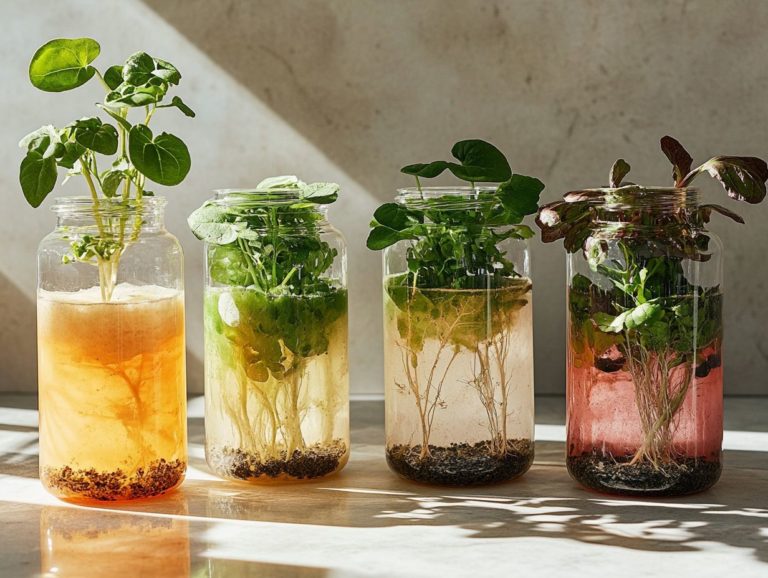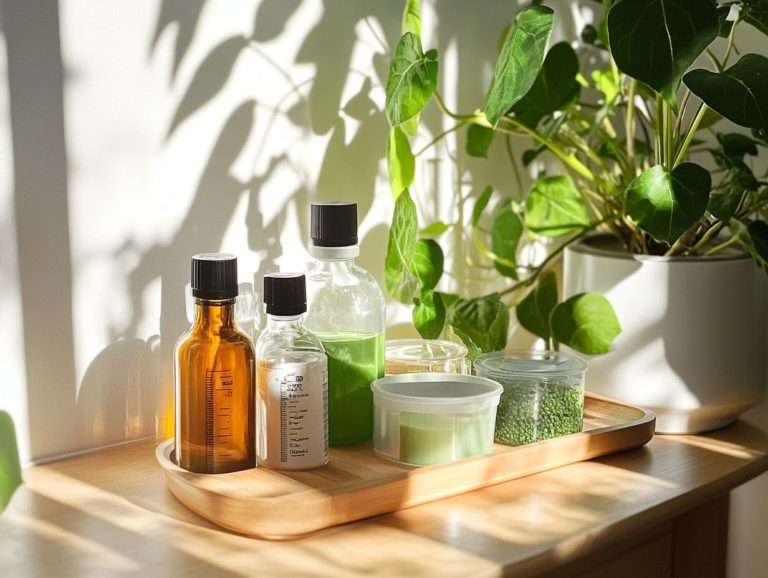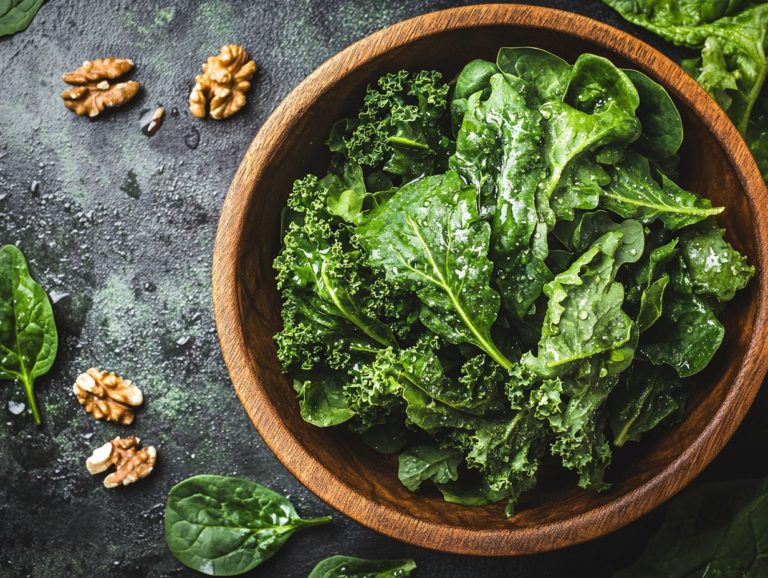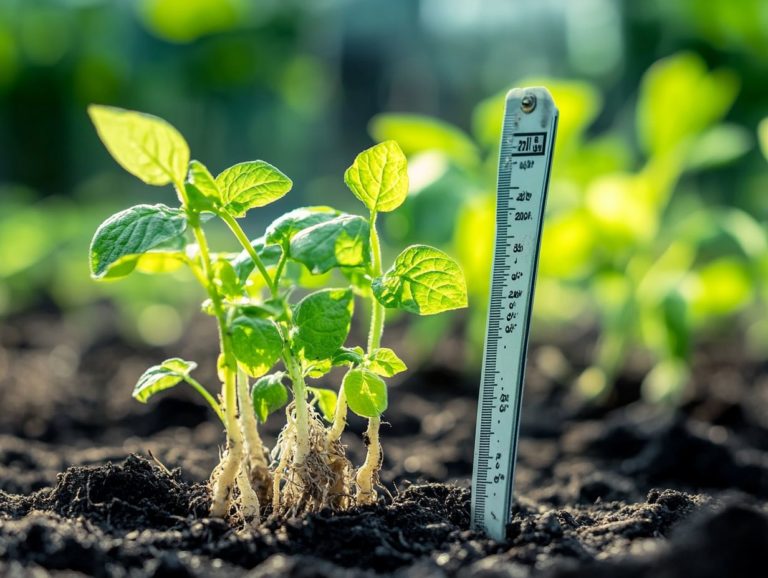5 Signs of Over-Fertilization in Hydroponics
Over-fertilization can be a stealthy adversary in your hydroponic garden, potentially leading to a host of issues that threaten the vitality of your houseplants.
Recognizing the signs of excess nutrients is crucial for every hydroponics enthusiast to prevent over-fertilizing.
This article delves into five key indicators of over-fertilization, including yellowing leaves, browning tips, and stunted growth. You’ll also discover how over-fertilization occurs, its common causes, and the most effective methods to correct over-fertilization and prevent further issues.
Whether you re an experienced grower or just embarking on your hydroponic journey, being able to identify and manage these challenges will empower you to maintain a flourishing system.
Contents
- Key Takeaways:
- 1. Yellowing or Browning of Leaves
- 2. Stunted Growth
- 3. Wilting or Drooping Plants
- 4. Buildup of Salt Deposits
- 5. Algae Growth
- How Does Over-Fertilization Happen in Hydroponics?
- What Are the Common Causes of Over-Fertilization in Hydroponics?
- How Can Over-Fertilization Be Prevented in Hydroponics?
- What Are the Best Ways to Correct Over-Fertilization in Hydroponics?
- What Are the Effects of Over-Fertilization on Plants in Hydroponics?
- How Can One Determine If Their Plants Are Over-Fertilized in Hydroponics?
- Frequently Asked Questions
- What are the signs of over-fertilization in hydroponics?
- Why does over-fertilization occur in hydroponics?
- How can I tell if my plants are being over-fertilized?
- What should I do if I suspect over-fertilization in my hydroponic system?
- Can over-fertilization be reversed in hydroponics?
- How can I avoid over-fertilization in my hydroponic system?
Key Takeaways:
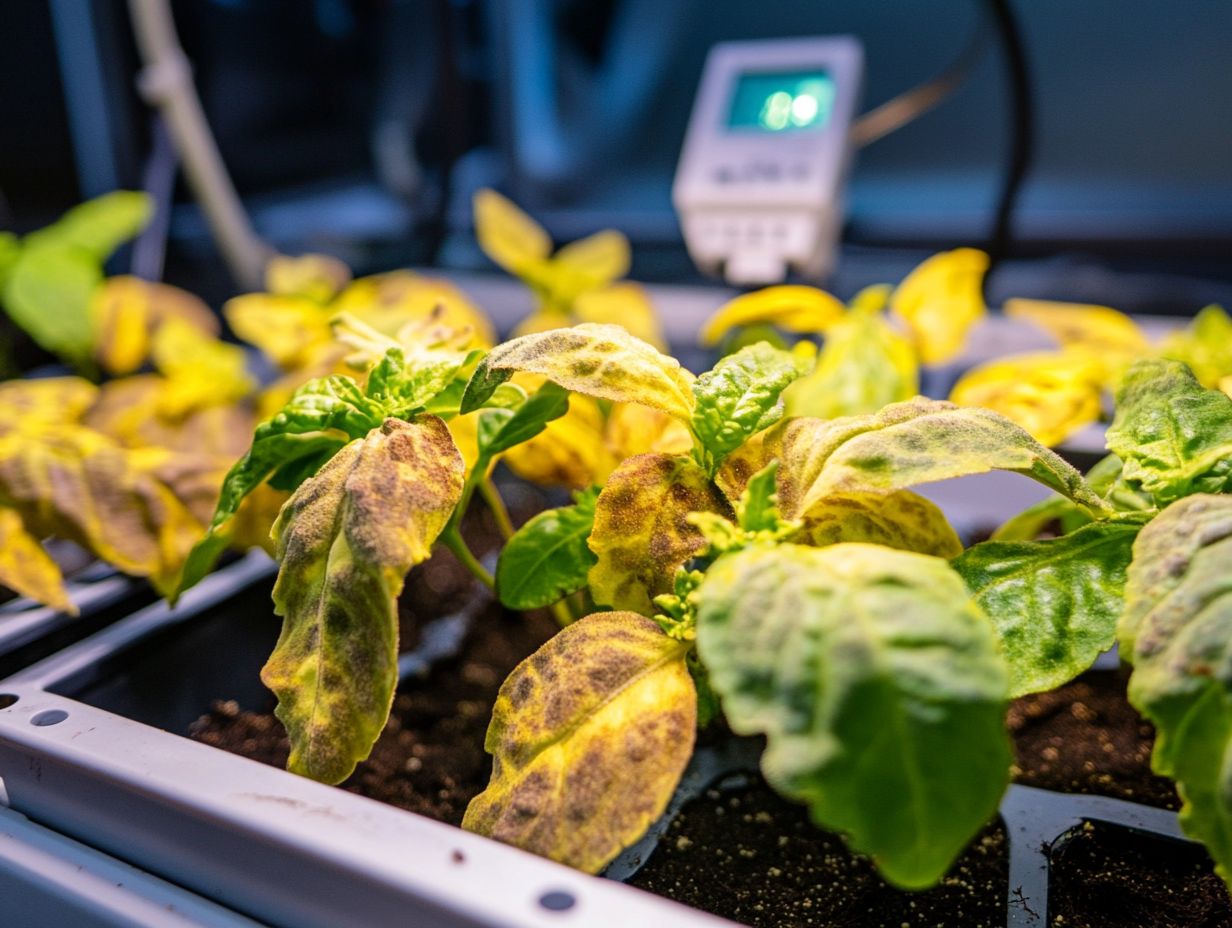
- Yellowing or browning leaves can indicate over-fertilization in hydroponics, as excess fertilizer can cause chemical burns or nutrient deficiencies.
- Stunted growth and wilting or drooping plants are also common signs of over-fertilization, as too many nutrients can disrupt the plant’s natural growth patterns.
- Buildup of salt deposits and algae growth can also indicate over-fertilization, as unabsorbed nutrients can accumulate and create an imbalanced environment for the plants.
1. Yellowing or Browning of Leaves
Yellowing or browning leaves in your houseplants can be quite alarming. They often signal a nutrient imbalance stemming from over-fertilization.
This not only leads to chemical burns but also compromises the overall health of your plant, impacting its moisture uptake and nutrient absorption capabilities.
When you apply fertilizers excessively, you disrupt the delicate balance essential for optimal chlorophyll production. This results in once-vibrant green leaves losing their luster. It can further hinder the plant’s ability to efficiently absorb water and crucial nutrients from the soil, creating a downward spiral of health issues.
Damaged roots may struggle to provide adequate support, leading to defoliation and other distressing symptoms. As those leaves begin to yellow or brown, it s essential to investigate the underlying causes. Making necessary adjustments in care will help restore vitality and prevent further decline.
2. Stunted Growth
Stunted growth in your houseplants can serve as a clear signal of nutrient pollution and deficiencies, particularly in essential elements like nitrogen, phosphorus, and potassium.
These nutrients are vital for promoting optimal plant growth and development. When these elements are in short supply, your plants may display slowed growth and poor health, ultimately affecting their ability to thrive indoors.
It s crucial to pay attention to your fertilization practices. Overdoing it can create an imbalance leading to nutrient lockout (when plants can t use certain nutrients because of too much fertilizer), resulting in stunted growth and diminished vitality.
To encourage robust growth, choose a balanced fertilizer formulated to meet your plants’ unique needs. Utilizing slow-release fertilizers and regularly monitoring soil nutrient levels will provide a steady supply of essential nutrients without overwhelming your plants.
3. Wilting or Drooping Plants
Wilting or drooping plants often signal improper watering practices or nutrient imbalances from over-fertilizing, which can hinder moisture uptake and potentially harm the roots.
Understanding proper watering guidelines is essential, as it directly affects your plants’ overall health and growth. Ideally, the soil should offer adequate drainage to prevent waterlogged roots, which can stress your plants and impede their ability to absorb vital nutrients.
Keep an eye out for signs like yellowing leaves or stunted growth; these often indicate over-fertilization and suggest that a more balanced feeding strategy is necessary. If you notice these symptoms, consider learning how to revive over-fertilized hydroponic plants. Establishing a consistent watering schedule is key to avoiding these issues, ensuring your plants receive just the right amount of moisture without drowning or starving their roots.
By being mindful of these factors, you can cultivate a thriving green environment that flourishes under your care!
Start monitoring your plants today to keep them healthy and thriving!
4. Buildup of Salt Deposits
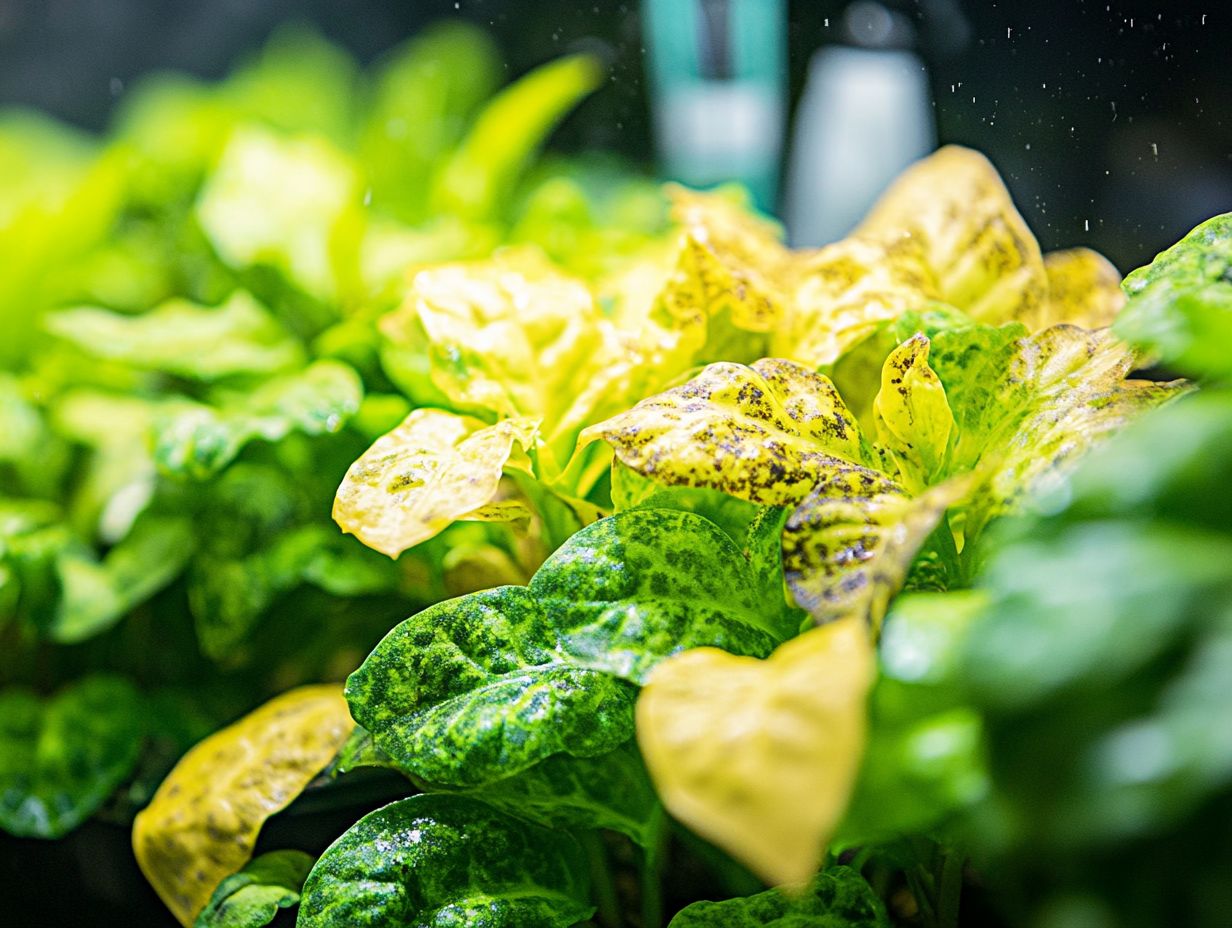
The buildup of salt deposits on the soil surface can signal a serious concern for houseplant owners like you, hinting at over-fertilization and the presence of dissolved salts that may inhibit nutrient absorption and lead to chemical burns.
This accumulation often stems from improper watering practices or the use of fertilizers high in salt concentrations, which can negatively impact your plants’ health over time.
To tackle this issue, you can take various corrective steps, such as thoroughly flushing the soil with clean water to wash away excess salts.
It s also wise to choose fertilizers specifically formulated for houseplants, such as organic compost or HYCLEAN those lower in salts and more readily absorbed by the roots. Incorporating moisture meters can significantly enhance your ability to monitor salt levels and moisture content in the soil, ensuring your plants receive optimal hydration without the risk of over-fertilization.
5. Algae Growth
Algae growth in your houseplant soil often signals a wrong mix of nutrients and over-fertilizing, suggesting that conditions are perfect for unwanted growth on the soil surface something that can hinder your plant care efforts.
Excessive algae competes with your houseplants for vital nutrients and moisture, ultimately weakening the foliage and stunting growth. To tackle this issue, you should embrace balanced fertilization, ensuring that nutrients are applied in moderation and only when truly needed.
Incorporating a moisture meter can enhance your soil management by accurately measuring moisture levels, allowing you to water at just the right time without risking oversaturation. Maintaining good soil conditions and monitoring nutrient levels helps promote healthy plants while keeping that pesky algae at bay.
How Does Over-Fertilization Happen in Hydroponics?
Over-fertilization in hydroponics can sneak up on you due to improper nutrient management, leading to high concentrations of dissolved salts that interfere with nutrient absorption. This can cause chemical burns to the delicate roots of your plants, especially in an indoor gardening setting.
This issue is particularly pronounced in hydroponic systems where there’s no growing medium, and your plants depend entirely on the precise blend of nutrients dissolved in water. Unlike traditional gardening, where nutrients gradually seep into the soil, hydroponics demands that you consistently monitor nutrient levels to ensure your plants receive the perfect balance for optimal growth.
Watch for signs of over-fertilization! Signs include leaf discoloration, wilting, or crisping at the edges, which can signal a salt buildup. Regular testing and adjustments are key to mitigating these risks and fostering a healthier, more productive hydroponic garden. Additionally, be aware of nutrient deficiency symptoms in hydroponics to ensure optimal plant health.
What Are the Common Causes of Over-Fertilization in Hydroponics?
Many things can cause over-fertilization in hydroponics, often stemming from improper fertilizer application, a lack of monitoring dissolved salts, and an insufficient grasp of nutrient balance. These oversights can lead to significant health issues for your plants, including root diseases.
This situation typically occurs when growers miscalculate nutrient concentrations, whether by over-applying fertilizer or neglecting the varying needs of different plants. Utilizing pH meters (which measure soil acidity) and moisture meters becomes essential for maintaining optimal growing conditions, as these tools provide crucial data that can help avert the detrimental effects of nutrient overload. Additionally, it’s important to be aware of signs your hydroponic system needs maintenance to ensure a healthy garden.
By regularly monitoring these parameters, you can ensure your plants receive the right balance of nutrients without veering into the danger zone of toxicity, ultimately promoting healthier growth and maximizing yields. Additionally, be aware of signs of overwatering in hydroponic plants to maintain optimal conditions.
How Can Over-Fertilization Be Prevented in Hydroponics?
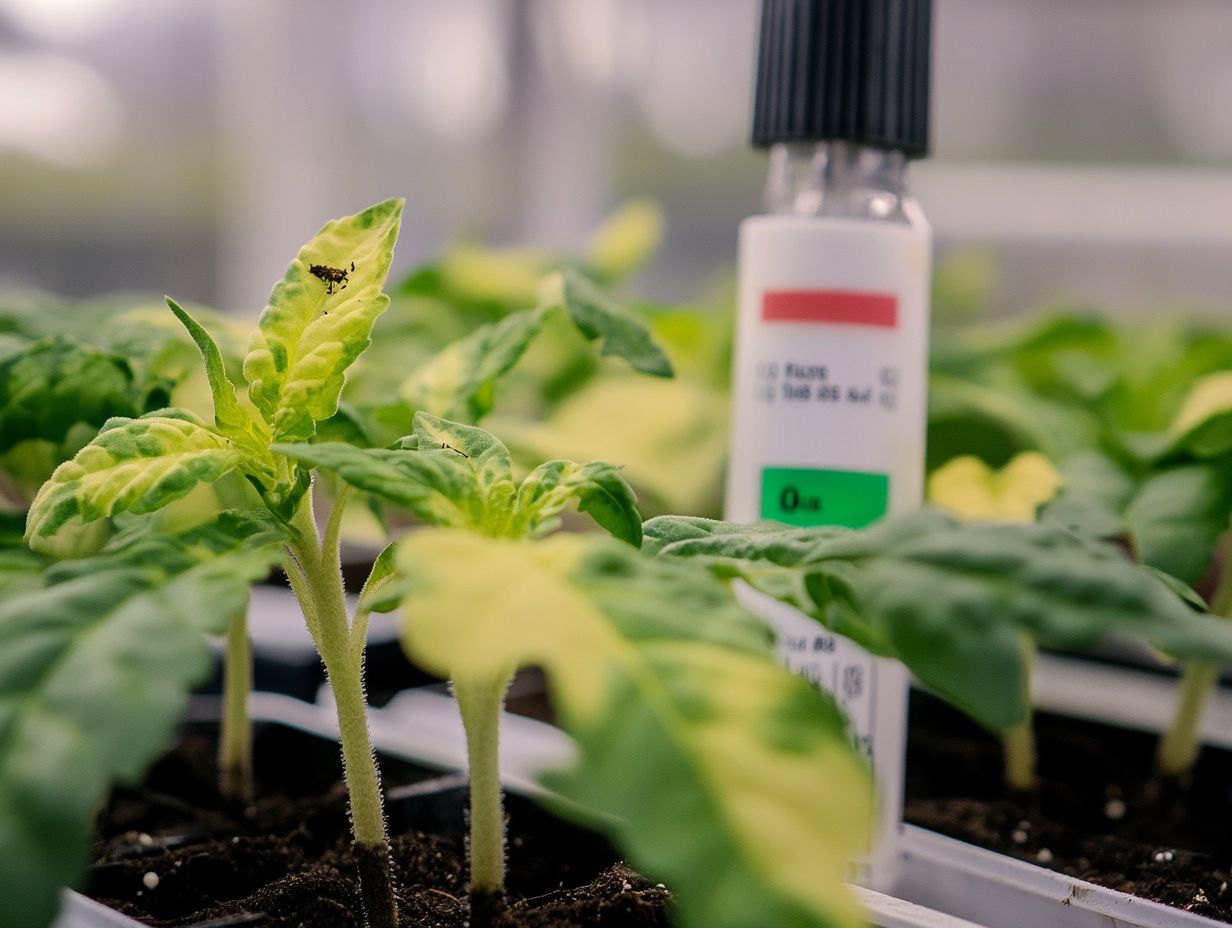
Preventing over-fertilization in hydroponics demands your unwavering commitment to careful nutrient management. This means keeping a close eye on fertilizer formulations and routinely checking with a pH meter to ensure optimal growing conditions for your plants.
You ll want to use testing kits to frequently analyze the nutrient solution, ensuring that the concentrations align perfectly with the specific needs of your crops. It s essential to recognize that different plants have varying nutrient requirements, and you should also consider environmental factors like light intensity and temperature.
By adjusting your fertilizer application strategies based on these insights, you ll promote healthier growth. Keeping a detailed record of nutrient levels and plant responses will help you fine-tune future applications. Regularly reviewing this data allows you to adjust your practices proactively, ultimately nurturing a thriving hydroponic garden.
What Are the Best Ways to Correct Over-Fertilization in Hydroponics?
Act quickly to correct over-fertilization to save your plants! Start by flushing the system to eliminate excess salts, reducing nutrient concentrations, and keeping a close eye on your plants for any signs of chemical burns.
Begin the process by draining as much of the existing nutrient solution as possible. Then, introduce a large volume of fresh, pH-balanced water into the system. This helps to remove the high concentration of fertilizers and resets the nutrient levels to their optimal ratios.
Consider adjusting how you give nutrients to your plants; using a lower concentration of nutrients can often enhance absorption while your plants recuperate. Make it a habit to regularly check the pH and electrical conductivity (EC) levels. Keep them within the desired range!
What Are the Effects of Over-Fertilization on Plants in Hydroponics?
The effects of over-fertilization on your hydroponic plants can be quite detrimental, leading to reduced health, impaired nutrient absorption, and an increased risk of chemical burns and root damage, ultimately hindering growth.
When nutrient levels surpass what’s necessary, you might notice your plants displaying distress signals like yellowing leaves, wilted stems, and stunted growth. Long-term exposure to excessive fertilizers can lead to nutrient excess, which occurs when plants can’t absorb nutrients due to too many fertilizers, jeopardizing the overall vitality of your plants.
This imbalance can also create an environment ripe for harmful pathogens, increasing the vulnerability of your system. To keep your hydroponic setup thriving, it s wise to conduct regular nutrient solution testing and stick closely to established feeding schedules. This keeps your plants healthy and happy!
How Can One Determine If Their Plants Are Over-Fertilized in Hydroponics?
Determining whether your plants are over-fertilized in hydroponics requires a keen eye for specific symptoms. Look for signs of nutrient imbalances, chemical burns, and poor moisture uptake these are clear indicators that something needs your immediate attention.
Regular monitoring is vital for ensuring your plants thrive, and employing tools like moisture meters and pH meters can greatly enhance your efforts. By keeping tabs on moisture levels, you can strike the perfect balance, ensuring the roots aren’t drowning or parched both conditions can amplify the signs of over-fertilization.
pH meters offer invaluable insights into nutrient availability in your solution, allowing you to make timely adjustments that prevent additional stress on your plants. With careful observation and the right tools, you ll be well-equipped to maintain optimal conditions, nurturing robust growth and bountiful yields.
Frequently Asked Questions
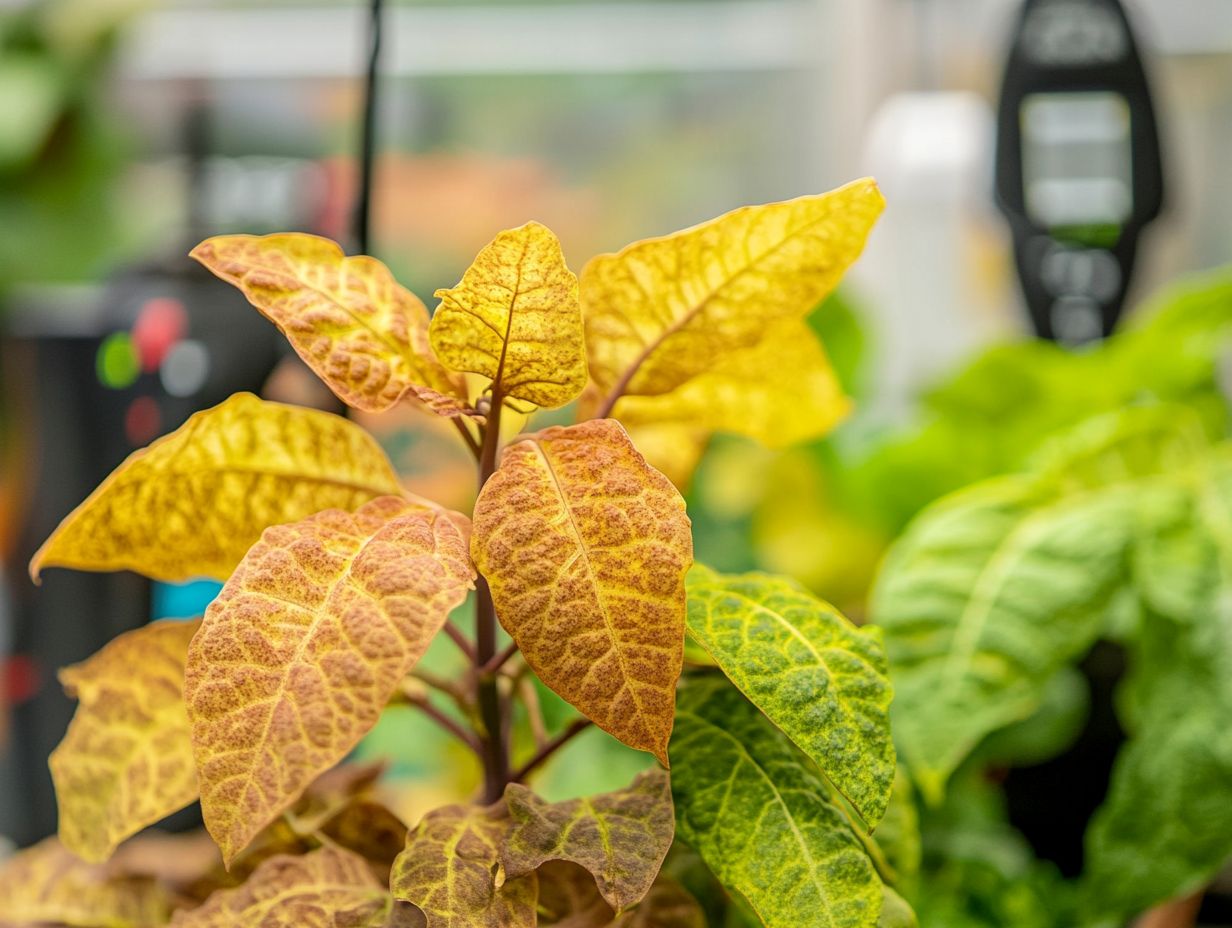
Take action today for a thriving hydroponic garden! Subscribe for more tips and resources related to hydroponics.
What are the signs of over-fertilization in hydroponics?
The most common signs of over-fertilization in hydroponics include wilting leaves, discolored leaves, stunted growth, root damage, and damage caused by too many nutrients.
Why does over-fertilization occur in hydroponics?
Over-fertilization happens because of incorrect nutrient concentrations, excessive feeding, or using low-quality nutrients.
How can I tell if my plants are being over-fertilized?
You can tell if your plants are over-fertilized by monitoring their growth and appearance closely. Watch for signs like wilting, discoloration, and stunted growth.
What should I do if I suspect over-fertilization in my hydroponic system?
If you think your system is over-fertilized, flush it with clean water right away. This will help remove extra nutrients and protect your plants!
Can over-fertilization be reversed in hydroponics?
Yes, over-fertilization can be reversed! Flush the system and adjust the nutrient levels to the right concentration. Acting quickly is crucial, as prolonged exposure to excess nutrients can cause more damage.
How can I avoid over-fertilization in my hydroponic system?
To avoid over-fertilization, accurately measure and mix your nutrients according to the provided instructions. Monitor your plants regularly and adjust nutrient levels as needed.
Keep an eye on your plants, and don t hesitate to reach out for help if something seems off!


